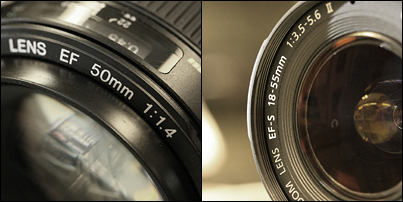Lens speed
From Wikipedia, the free encyclopedia
Lens speed refers to the maximum aperture diameter, or minimum f-number, of a photographic lens. A lens with a larger maximum aperture (that is, a smaller minimum f-number) is a fast lens because it delivers more light intensity (illuminance) to the focal plane, allowing a faster shutter speed. A smaller maximum aperture (larger minimum f-number) is "slow" because it delivers less light intensity and requires a slower shutter speed.
A lens may be referred to as "fast" or "slow" depending on its maximum aperture compared to other lenses of similar focal length designed for a similar film format. Lens speed given by the minimum f-number, or alternatively maximum aperture diameter or maximum numerical aperture, is a useful quantitative way to compare similar lenses.
Lens speed is important in taking pictures in dim light, or with long telephoto lenses. For controlling depth of field, especially in portrait photography[1], lens speed is a key variable in combination with other variables such as focal length and camera format size.
Lenses may also be referred to as being "faster" or "slower" than one another using this same method. A lens with a maximum aperture of f/3.5 is faster than one with an aperture of f/5.6, though neither is especially fast. A lens with an aperture of f/1.8 is slower than a lens with an aperture of f/1.2, though both are fast lenses.
The range of lenses considered "fast" has evolved to lower f-numbers over the years, due to advances in lens design, optical manufacturing, and quality of glass and optical coatings. For example, the 1911 Encyclopaedia Britannica states that "...[Lenses] are also sometimes classified according to their rapidity, as expressed by their effective apertures, into extra rapid, with apertures larger than f/6; rapid, with apertures from f/6 to f/8; slow, with apertures less than f/11." (Here, interpretation of "apertures less than f/11" requires literal interpretation as aperture diameters less than focal length divided by 11, equivalent to saying "f-numbers greater than 11.")
With 35 mm cameras, the fastest lenses are typically in the "normal lens" range near 50 mm. Longer telephoto designs and wide-angle retrofocus designs tend to be slower. Also, "prime" (fixed focal length) lenses generally tend to be faster than zoom lenses[2].
Lens speed also tends to correlate with the price and/or quality of the lens. This is because lenses with larger maximum apertures require greater care with regard to design, precision of manufacture, special coatings and quality of glass. This is not a hard and fast rule, however, as there are several high-quality fast lenses available that are relatively inexpensive, particularly in normal lens focal lengths.
Contents |
[edit] Fast lenses

Some of the fastest camera lenses ever made are:
- Carl Zeiss 50mm f/0.7 (Limited production lens built for the NASA space program, used on 35mm movie cameras by Stanley Kubrick for some candlelit scenes in Barry Lyndon)
- Tokyo Kogaku Toko 5cm f/0.7 (WWII) and Simlar 5cm f/0.7 (1951, only three were produced, two of which were used on a South pole expedition)[3]
- Rodenstock TV-Heligon 50mm f/0.75
- Nikon TV-Nikkor 35mm f/0.9-Fastest Nikon lens ever made[4]
- Leica Noctilux-M 50 mm f/0.95 ASPH, announced on September 15, 2008, it is the fastest Aspherical lens to have ever reached mass production, with a MSRP of £6290.[5]
- Canon 50mm f/0.95 (Available in TV and Canon 7 Rangefinder Version)
- Schneider Kreuznach 50mm f/0.95 'Xenon' (Available with C mount)
- Leica Noctilux 50mm f/1.0 (Leica M mount, discontinued and replaced 2008 with a new Noctilux, see above)
- Canon EF 50mm f/1.0 (for Canon autofocus SLR, now out of production)
[edit] See also
[edit] References
- ^ Waldren, Margaret (and others) Advanced Digital Photography 2004 Media Publishing
- ^ Long, Ben Complete Digital Photography 2004 Charles River Media
- ^ "Topcor Lenses No. 8". http://www003.upp.so-net.ne.jp/Topconclub/lens8.htm. Retrieved on 2009-02-14.
- ^ "TV-Nikkor 35mm F0.9 Big First Super Light". http://homepage2.nifty.com/akiyanroom/redbook-e/repro/tv.html. Retrieved on 2009-02-14.
- ^ "Leica offers World's fastest Aspherical lens". Leica. 2008-09-15. http://www.dpreview.com/news/0809/08091505leica_50mm_f0_95.asp. Retrieved on 2009-02-14.
[edit] External links
- Just how fast is that lens? f-number doesn't directly determine focal-plane illuminance, due to light transmission losses.


